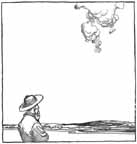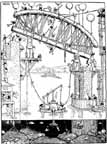Three Kinds of Book Illustration
W. Heath Robinson, one of the great late-Victorian early-twentieth-century illustrators, had at least four different styles though they don't always coicide precisely with particular periods in his career. The first, which appears in many of his illustrations for Cervantes (1902), Rabelais (1904), and The Queen's Story Book (1898), uses fine individual penstrokes to represent texture and shadow. Revealing the influence of Richard Doyle, Phiz, and other early- and mid-Victorian illustrators, works in this style often resemble woodblock engraving.


Two of W. Heath Robinson.'s styles. Left: The Night's Plutonian Shore. Right: Man contemplating the sea by W. Heath Robinson.
[Click on thumbnails for larger images.]
The second style, which reveals the influence of Phil May and Aubrey Beardsley, shows Robinson taking full advantage of the new photographic process' capacity to create large areas of solid black and white. This style in which the artist created some of his greatest work itself takes several forms or variants. In one, represented by the page decoration that begins The Song of the English (1909) or its illustrations of a castle and trees or polar bear on the artic ice, he contrasts solid area of black and white. A few of the plates for The Song of the English, such as one for "England's Answer" and "Capetown," emphasize large areas of blackness, though Robinson appears to have used this approach more in the Midsummer Night's Dream, the 1900 Poems of Edgar Allan Poe, and the 1902 Uncle Lubin than in any other work. Equally striking are his plates with large area of white, which take various forms, including vignetted drawings like the drowned castaway in "The Song of the Dead," rectangular illustrations like the man contemplating the sea in "England's Answer," and his elegant line drawings against bare backgrounds, such as appear in illustrations to Perrault's Old Time Stories (1921). Some of the most brilliant of these white-space illustrations show the obvious influence of Japanese prints: in his illustration for "The Coastwise Lights" (1909), "They carried the mirror" from Andersen's Fairy Tales (1913), and "The first thing Tom saw" from The Water Babies (1915), all create spatial depth in the Japanese manner by vertical movement up the picture space rather solely by Rennaissance perspective. Many of these white space works also reveal another '90s influence as Robinson renders clouds, smoke, or water in Art Nouveau swirls. The ocean currents in an illustration for "The Song of the Dead" (1909) and the campfire smoke in one for "The Song of the Sons" (1909) exemplify his use of swirling s-curves as a visual motif.

Came the whisper, came the Vision by W. Heath Robinson.
Like Willy Pogány and Arthur Rackham, Heath Robinson also created lavisly illustrated deluxe books that combined monochrome line drawing with tipped-in color plates. These do not represent his finest work. Some, like "Follow After" and "Capetown," resemble some of Rackham's work in having the appearance of colored line drawings while others, like "Lord God, we ha' paid in full!" and "Came the whisper" show a greater skill with watercolor; yet others, like "We that were bred overseas" and "Halifax" appear muddy.
The Momement away from Book Illustration

The Building of the Saltash Bridge by W. Heath Robinson, 1935
Heath Robinson's last style, which first appears during the first World War and continues to the end of his career, takes the form of cartoons and other humorous drawings depicting what John Lewis, his biographer, well describes as "improbable inventions and absurd situations" (p. 150). A "Heath Robinson" in the U. K. is more or less the equivalent of what Americans would call a "Rube Goldberg" -- an absurdly complicated and ingenious device such as we see in "The Building of the Saltash Bridge" and "The American Suction Tank." Although many of these humorous drawings, such as "The inventor of the mechanical shovel," take the form of simple outlines, others use oppositions of black and white areas characteric of Robinson's book illustrations and yet others have large areas of flat color.
Bibliography
Lewis, John. Heath Robinson: Artist and Comic Genius. London: Constable, 1973.
Robinson, W. Heath. My Line of Life. London: Blackie and Sons, 1938.
Last modified 6 March 2005